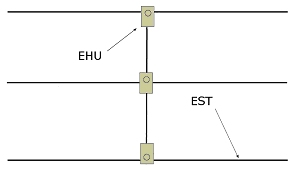|
I installed my 3 element SteppIR antenna a few years ago and I've really enjoyed using it daily. It's never given me a moment's worry having such advanced technology working 30 meters in the sky; but I heard that a few owners have complained about receiver noise when the antenna changes frequency. Others have mentioned "dead spots" when receiving which, they report, clear up with the application of RF.
Their theory is that there might be some corrosion on the retractable beryllium-copper strips which make up the antenna elements.
Though I don't personally have this problem on my SteppIR, I decided, as a service to the SteppIR community, to try to design a solution for this situation by combining two of my hobbies, Ham Radio and African Pygmy Mouse breeding.
While I don't have the photos ready to post showing the construction of what I'm calling "QAAM - Quiet As A Mouse"® SteppIR Element Cleaning, I am publishing how it works (along with my engineering drawings) as part of my copyright and patent protection process.
I raise African Pygmy mice (MUS Minutoides) that I sell to pet stores as living snake food. While very small, these mice accept training equally well as full-sized mice. The average pygmy mouse is only about 70mm in length including tail making them perfect for this application.

A brief overview of SteppIR technology
SteppIR antennas are designed with a device called an Element Housing Unit (or EHU) containing two reels of copper-beryllium tape that can be extended and retracted (under program control) to form a Yagi element. The tape rides inside hollow fiberglass tubes called Element Support Tubes (or ESTs). One EHU and a pair of ESTs form a Yagi element. One of these makes a dipole and two or more are used for multi-element antennas. This elegant design yields resonant antenna lengths on bands from 6m to 20m or 40m (depending on the antenna model).

The QAAM design approach
If I could find a way to introduce a pygmy mouse into each EST and train them to run back and forth with some way of carrying a cleaning substance or device, we might have a solution.
This project involved several steps:
1) I modified the SteppIR Element Housing Unit (EHU) by drilling a 1/2" hole (the Mouse Access Port) in the top of each.
2) I fabricated a small, ventilated Plexiglas box and cemented it with epoxy to the top of each EHU. The box has a small trapdoor in the top, ventilation holes and unique (and this was the hard part) water system, driven by demand, to pump water up and into a small (soft drink bottle cap-sized) reservoir. There is also a food block (food bound with a nutritional bonding agent making the food block something like a Granola bar. I also installed a small, readily available exercise wheel in each box for off-duty exercise. The Plexiglas box is covered in UV resistant film for light and temperature control.

3) I trained three mice (you'd need four for a 4El SteppIR) on a bell signal to go down from their box/habitat into the EHU and run to the end of each of the two Element Support Tubes (EST) and then run back three times. I did this with simulated ESTs in the lab of course, until each mouse's performance was ingrained and natural.
4) I used an unused pair of wires in the control cable (I originally ran 16- conductor thinking I might one day have a 4-Element SteppIR but my lot size prohibits that) with a doorbell mechanism mounted in a weatherproof box on the mast below the boom and a simple pushbutton in the shack (schematic available but, sadly, not in time for publication). NOTE: One important part of the circuit was use to lock out the bell trigger if the rig was in transmit mode. Even 100w of RF is enough to permanently "discourage" the mouse in the driven element. And that just leads to unnecessary maintenance.
5) My wife sewed up a little vest for each mouse (and these are tiny animals) with a graphite panel on each side. I made the graphite panels from matchbook strike strips.

6) I introduced one trained and now, vested, mouse into each EHU/Habitat via the aforementioned trapdoor.
Training the mice
We used Pavlovian technique in training the mice. They soon learned that the bell was the trigger to run the length of each of the ESTs and back; it took a while to ingrain the "run the circuit three times" instruction but eventually they "got it". One interesting aside: We failed completely to train a single female mouse. Not one. Each one looked at us as if we were crazy. No explanation. The males, on the other hand were eager to please!
How it works
When I want to clean the element tapes, I simply extend the elements to 14.0Mhz (fully extended, that is) and ring the bell from the shack. The "not while transmitting" lockout is (as mentioned above) a vital part of the circuit.
Each trained mouse comes down from its habitat and runs down the tubes with the graphite panels on the side of their vests removing any built-up corrosion as they go! Their training causes them to do this three times and then sends them back up into their habitat.
Voila! It worked!
What we learned before going into production
I can't emphasize the importance of adequate testing before bringing such a product to market.
We tested with the test element at table height.
The "alpha" design for the mouse-vest had graphite strips on only one side. We were unable to get the mice to consistently run along only one side of the tape; an easy fix to was to add a strip to the other side of the vest so it didn't matter which side the mouse chose. An added benefit is that we get cleaning action as the mouse runs both ways.
Since the food block needs replenishing (our first design only lasted about two weeks before being consumed; these little guys are hungry) it's important to be able to lower the tower to replace the food blocks. But we learned that the size of the food block could be quadrupled without difficulty so we were able to reduce the number of times the tower had to be lowered to about once only every eight weeks.
The water delivery system was problematic at first. It's designed to replenish the tiny drinking reservoir when the level gets low. A submersible aquarium pump at the base of the tower pumps water through 1/4" clear plastic hoses to each of the EHUs. The pump is attached to the house main. A wee float is used to open the valve at the drinking reservoir as the water level falls. No problem! Remember to leave enough "drip loop" in the tubing to account for the beam turning.
Testing continues
We ran the system for a month working out the kinks before lifting the completed 3-element system into place a the top of my 30m tower. It's been working fine for almost three years. And the mice seem contented and do their jobs well.
Conclusions
This was as close to a self-cleaning system as I could come up with. The mice used are fully grown and their life span is about 80 months so I won't need to "service" the system for some time yet.
FAQ
Does QAAM work with the MonstIR or the other 40m versions?
Yes, quite nicely. The additional element length on the MonstIR is no problem for the mice; they actually seem to enjoy the additional exercise!
I have "trombone" elements; will that work OK?
Yes; as with the longer ESTs on the MonstIR, the mice LOVE the extra distance; more exercise, healthier mice!
What happens when a mouse, well, dies?
We haven't had to deal with that question yet. Our assumption is that since the mouse spends most of his time in the habitat, the odds ar that is where he'll be when he expires. You'd lower the tower, remove the "out-of-service" mouse and replace with a freshly trained one. We always have trained mice available for replacement; see price list below.
I'm thinking of buying a breeding pair; what's your advice?
Well, we don't recommend that (though we do make breeding pairs available) since you'd have to do the training yourself and, believe me, that is a real chore. Also, as mentioned above, we've been able to train male mice only; the female mice simply won't perform. They look at you as if you're nuts for some reason.
What do the folks who make the SteppIR antenna think about this?
Frankly, they think the whole thing is ridiculous and unnecessary; and cutting the hole in the top of the EHU voids their warranty but, hey, whose antenna is this anyhow?!?
We make trained mice available in sets of three or four and the EHU/habitat boxes in sets of three or four as well.
Pricing
| Set of three habitats and three mice: | $1,200 | |
Set of four habitats and four mice: | $1,600 |
Set of three mice (only) | $300 |
Set of four mice (only) | $400 |
(*)Breeding pair: | $250 |
(*) With this option, training your own mice is an end-user responsibility and is not recommended; habitats not sold separately.
Use the email address at the end of this article for ordering/shipping information. And please, no contact or questions to or about the ASPCA; they've been driving us nuts about this.
NOTE: This project is in no way endorsed by Fluid Motion Inc., designer of the SteppIR family of antennas.
Questions? Ready to order? Click
.

Chaz W4GKF
|

